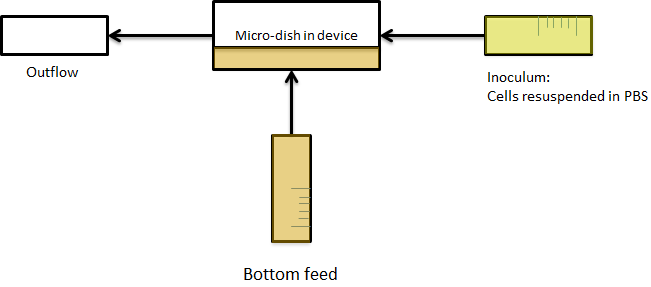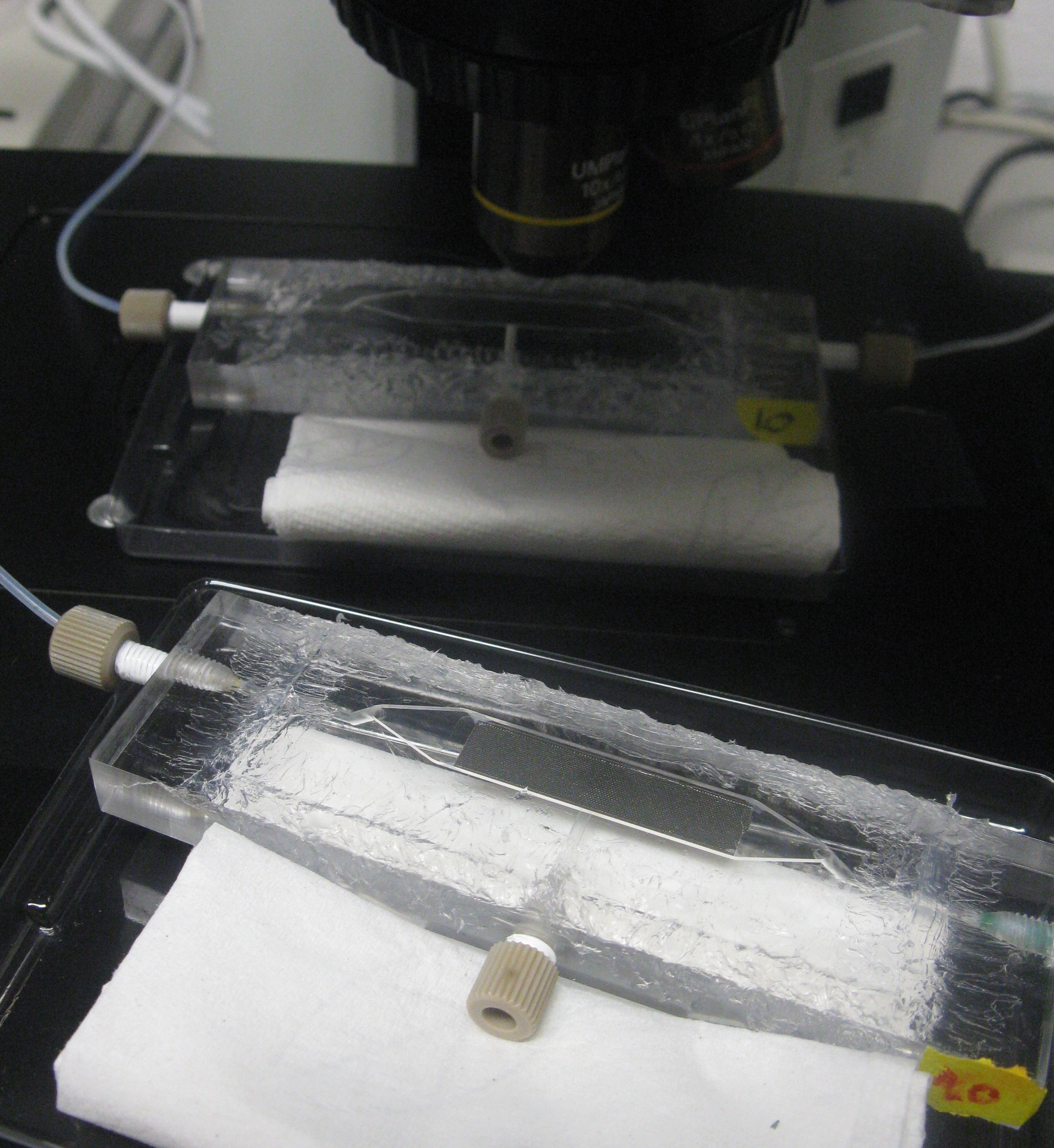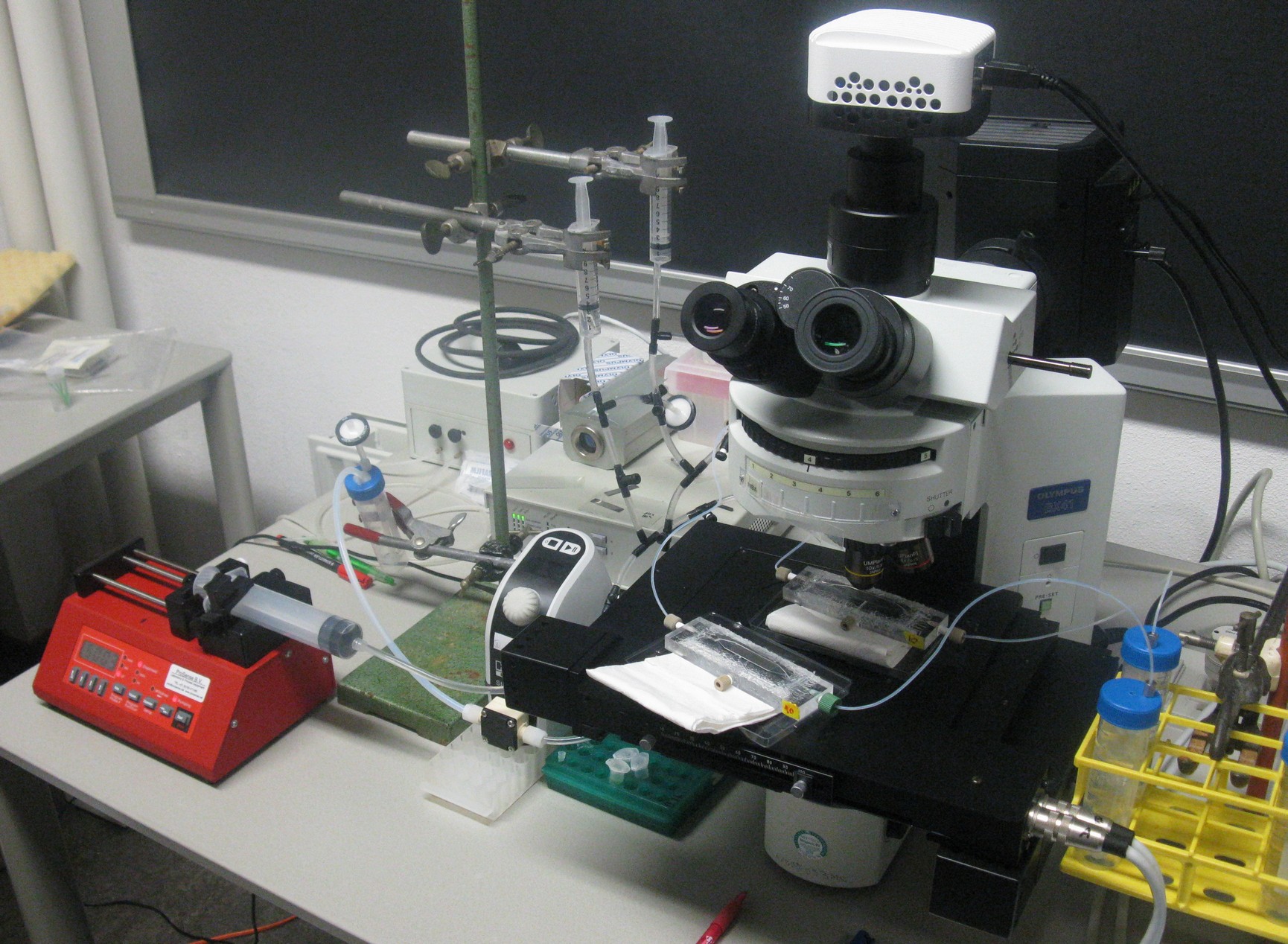Team:Wageningen UR/Project/DevicesSetup
From 2011.igem.org
(→Customa fluidic device designed by Team Wageningen UR to measure oscillations) |
(→Custom fluidic device designed by Team Wageningen UR to measure oscillations) |
||
| Line 24: | Line 24: | ||
=== Setup === | === Setup === | ||
| + | <!-- | ||
| + | In order to physically constrain the bacteria, Hasty used a trapping chamber as depicted in Figure Xsome below. The chamber had the dimensions of 1X1 micron. This limited the cell growth to forming a monolayer (sentence). Excess cells and AHL were flushed away through the main chanel. [REF] | ||
| - | + | [[File:Hasty_device_WUR.png|250px|center]] [ref] | |
| - | + | [[File:Legend_device_WUR.png|180px]] | |
| - | + | ||
| + | To create a monolayer, the micro-sieve seemed promising. The cells could be drawn toward the sieve by manually applying an under pressure with a syringe. Since the Top10 ''e.coli'' strain used for our transformations does not form biofilms, additional cells would be flushed away once all the pores of the micro-sieve are blocked. However the resulting flow over this monolayer turned out to be in the wrong dimensional plane (how to say this?). The direction of the flow over the micro-sieve can be seen in figure Xsome+1. | ||
| + | [[File:Micro-sieve_device_WUR.png|300px|center]] | ||
| + | |||
| + | The setup as shown above imposes the problem that the diffusion of AHL is much slower than the flow rate over the sieve. Therefore the AHL will always be flushed away before a uniform concentration can be established over the whole cell culture, thus preventing any synchronized behaviour to arise. The use of a micro-sieve in the course of our iGEM project was therefore discarded. | ||
| + | |||
| + | |||
| + | [[File:Micro-dish1_device_WUR.png|350px|center]] | ||
| + | |||
| + | <!-- [[File:Flushingoutofwells_WUR.gif|280px]] --> | ||
| - | |||
| - | |||
| - | |||
| - | |||
[[File:Micro-dish2_device_WUR.png|300px|center]] | [[File:Micro-dish2_device_WUR.png|300px|center]] | ||
| - | + | As a result, the bacteria were bottom fed as seen in the scheme in figure Xsomeplussomemore. This allowed the measurements to be taken continuously for various hours. | |
| - | + | ||
| - | + | ||
| - | + | [[File:Bottom_feed_WUR.png|500px|center]] | |
| + | '''Fig.Xwhatever:''' ''Applying bottom feeding to keep the cells in the wells alive'' | ||
| - | |||
| - | |||
| - | + | [[Team:Wageningen_UR/Project/ModelingProj1#Modeling_synchronized_oscillations| back to top]] | |
| + | --> | ||
| + | |||
| + | Another concern for the setup of the device was to be able to gain control over the flow rate. According to Bernoulli's principle, the velocity of a fluid can be influenced by varying the height of the medium bottle. This approach was also used in the paper cited above. Figure X. shows the corresponding setup and the applying equations. | ||
[[File:Scheme_setup1_WUR.png|500px|left]][[File:Setup1_WUR.JPG|250px]] | [[File:Scheme_setup1_WUR.png|500px|left]][[File:Setup1_WUR.JPG|250px]] | ||
| Line 64: | Line 70: | ||
'''Fig.X:''' ''Setup of the device using Bernoulli's principle to control the velocity of the fluid.'' | '''Fig.X:''' ''Setup of the device using Bernoulli's principle to control the velocity of the fluid.'' | ||
| - | However, as | + | However, as described on the [[Team:Wageningen_UR/Project/ModelingProj1#Conclusions_for_our_system| modeling page]], the dimensions of our fluidic device did not allow the aimed for precise control over the flow rate. This was tested both by calculating some theoretical values applicable for our device and running pilot experiments with water. Furthermore the obtained flow rates were also much faster than the flow rates in which oscillations were to be expected. This was solved by expanding our setup to incorporate the use of a syringe pump which controls the inflow. Figure X+1 shows the new setup. |
[[File:Scheme_setup2_WUR.png|500px|center]] | [[File:Scheme_setup2_WUR.png|500px|center]] | ||
| Line 85: | Line 91: | ||
| - | |||
| - | |||
| - | |||
| - | |||
| - | |||
| - | |||
| - | |||
| - | |||
| - | |||
| - | |||
| - | |||
| - | |||
| - | |||
| - | |||
| - | |||
Revision as of 17:01, 19 September 2011
 "
"










